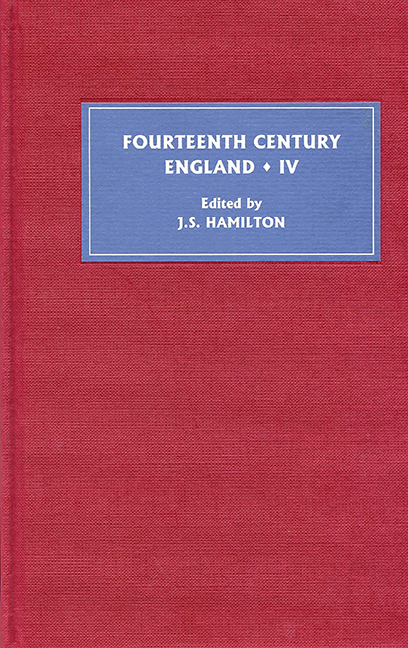Book contents
- Frontmatter
- Contents
- List of Illustrations
- Contributors
- Preface
- Abbreviations
- Who was St Thomas of Lancaster? New Manuscript Evidence
- ‘Hedging, Ditching and Other Improper Occupations’: Royal Landscapes and their Meaning under Edward II and Edward III
- Paying for the Wedding: Edward III as Fundraiser, 1332–3
- The Politics of Privilege: Thomas Hatfield and the Palatinate of Durham, 1345–81
- Agnes Maltravers (d. 1375) and her Husband John (d. 1364): Rebel Wives, Separate Lives, and Conjugal Visits in Later Medieval England
- Gendering Pastoral Care: John Mirk and his Instructions for Parish Priests
- Prosecution of the Statutes of Provisors and Premunire in the King's Bench, 1377–1394
- ‘Mercy and Truth Preserve the King’: Richard II's Use of the Royal Pardon in 1397 and 1398
- Aliens in the Pardons of Richard II
- ‘Too Flattering Sweet to be Substantial’? The Last Months of Thomas, Lord Despenser
- ‘O Prince, Desyre to be Honourable’: The Deposition of Richard II and Mirrors for Princes
- Regional Politics, Landed Society and the Coal Industry in North-East England, 1350–1430
‘Hedging, Ditching and Other Improper Occupations’: Royal Landscapes and their Meaning under Edward II and Edward III
Published online by Cambridge University Press: 12 September 2017
- Frontmatter
- Contents
- List of Illustrations
- Contributors
- Preface
- Abbreviations
- Who was St Thomas of Lancaster? New Manuscript Evidence
- ‘Hedging, Ditching and Other Improper Occupations’: Royal Landscapes and their Meaning under Edward II and Edward III
- Paying for the Wedding: Edward III as Fundraiser, 1332–3
- The Politics of Privilege: Thomas Hatfield and the Palatinate of Durham, 1345–81
- Agnes Maltravers (d. 1375) and her Husband John (d. 1364): Rebel Wives, Separate Lives, and Conjugal Visits in Later Medieval England
- Gendering Pastoral Care: John Mirk and his Instructions for Parish Priests
- Prosecution of the Statutes of Provisors and Premunire in the King's Bench, 1377–1394
- ‘Mercy and Truth Preserve the King’: Richard II's Use of the Royal Pardon in 1397 and 1398
- Aliens in the Pardons of Richard II
- ‘Too Flattering Sweet to be Substantial’? The Last Months of Thomas, Lord Despenser
- ‘O Prince, Desyre to be Honourable’: The Deposition of Richard II and Mirrors for Princes
- Regional Politics, Landed Society and the Coal Industry in North-East England, 1350–1430
Summary
To the treasurer and barons of the exchequer. Order to cause the prior and convent of Ivychurch, Andrew de Grymstede, John de Grymstede, Philip Gogeon, Robert de Micheldevre, and Robert le Peleter to be discharged of the rent of certain assarts that they had in the forest of [Clarendon], as the king has caused the assarts to be taken into his hands and inclosed within his park of [Clarendon].
The above order, issued from Windsor by Edward II in November 1317, lies behind the writing of this paper. Almost a throwaway reference that has hitherto been overlooked by scholars of Clarendon Palace and its park, the mandate might be considered at best noteworthy (and at worst insignificant) by late-medieval landscape historians. Yet at a local level its unambiguity, verified by other documentary sources, reveals that while Clarendon Park in Wiltshire is undeniably ancient, its size did not remain constant throughout the late medieval period. The deer park, which is among the best-preserved medieval royal hunting spaces in the country, is well-known as the largest ever to have existed in England (and probably in Europe). At around 16 km (about 10 miles) in circumference and 1,737 hectares in area, it far exceeded the average of 40–120 hectares. But what we see today may well be the result of an imparkment carried out not by Henry III when the palace was at its zenith, as is commonly supposed, but by Edward II, who apparently showed rather less interest, and at a time when Clarendon was rarely visited by the court.
The assarts in question first appear in records of arrentations of wastes ordered to be taken in 1299–1305 by Edward I. An inquisition into the same, held at nearby Salisbury in 1304, shows that the prior held 112 acres, le Peleter 32½, the de Grimsteads 20 and de Micheldevre 22. True, this is considerably less than the park's present 4,292 acres, but the assarts may only have been recorded due to their arrented status, while land pertaining to the king alone was left unmentioned. It is possible, given the areas occupied, to suggest that the assarts were located in the south and east of the park (see Figure 1).
- Type
- Chapter
- Information
- Fourteenth Century England IV , pp. 26 - 42Publisher: Boydell & BrewerPrint publication year: 2006

